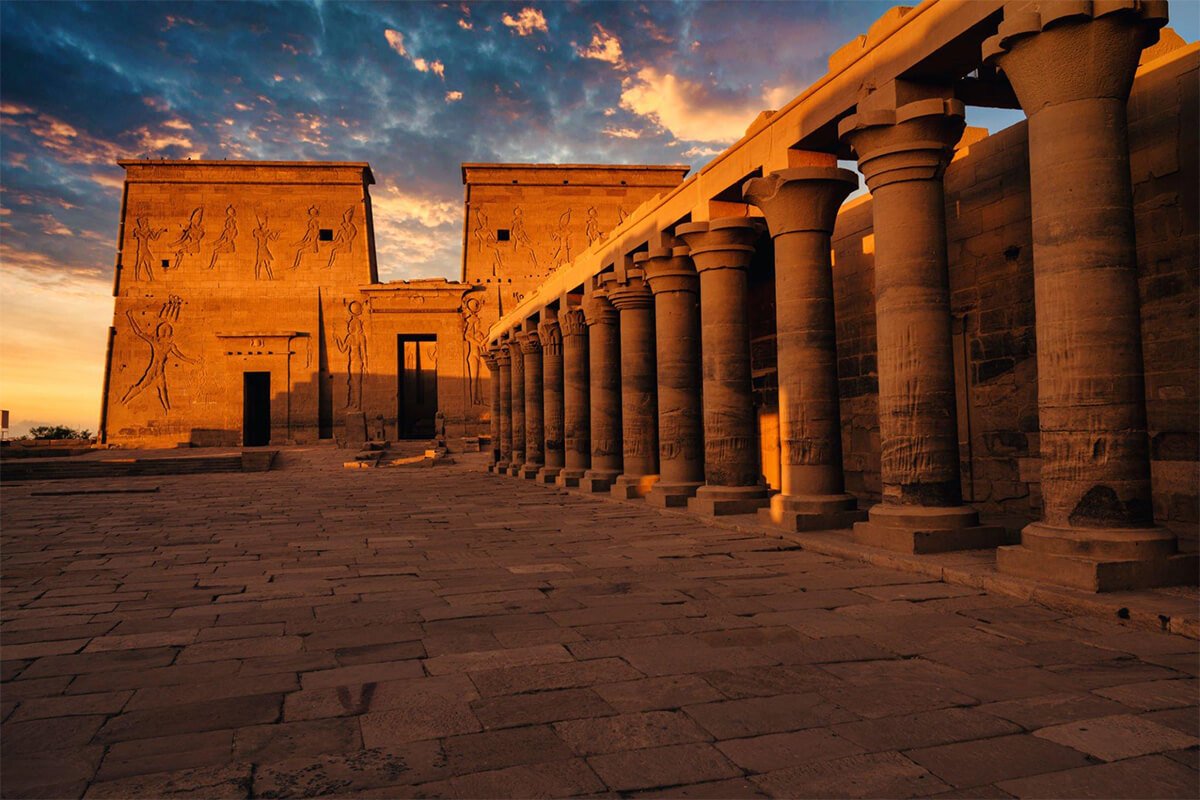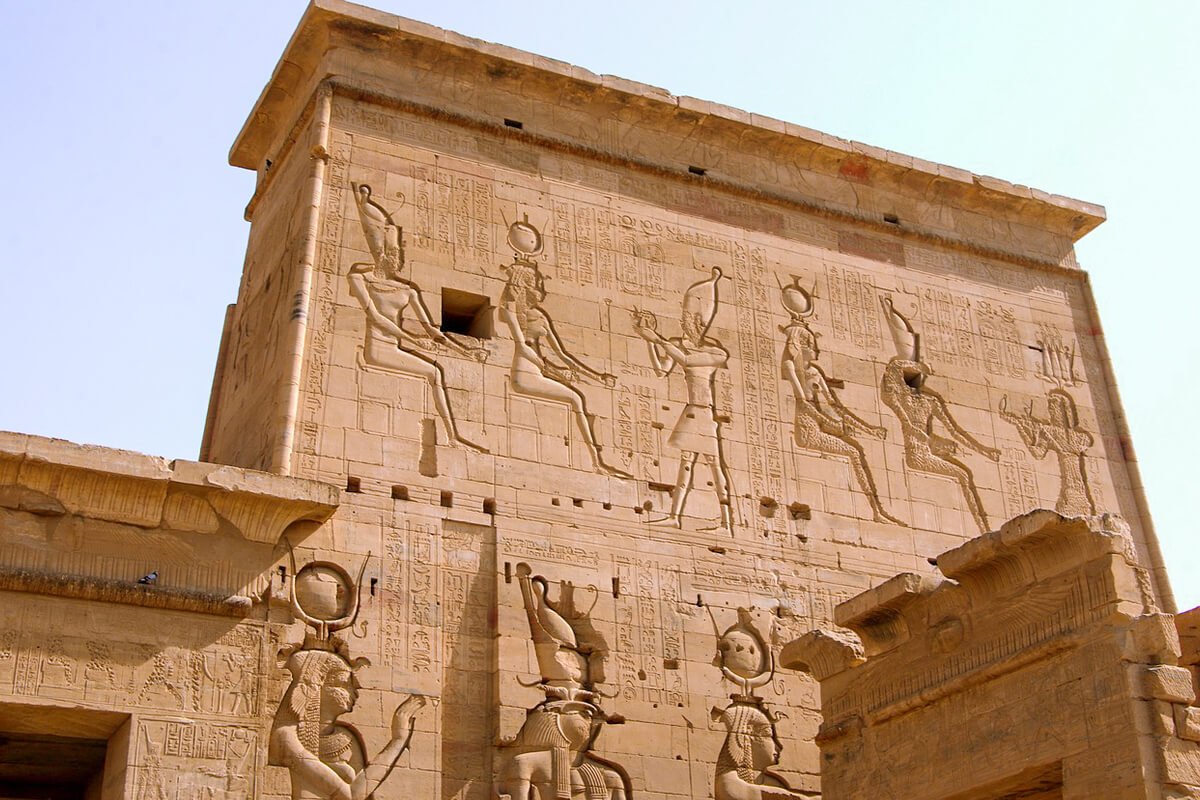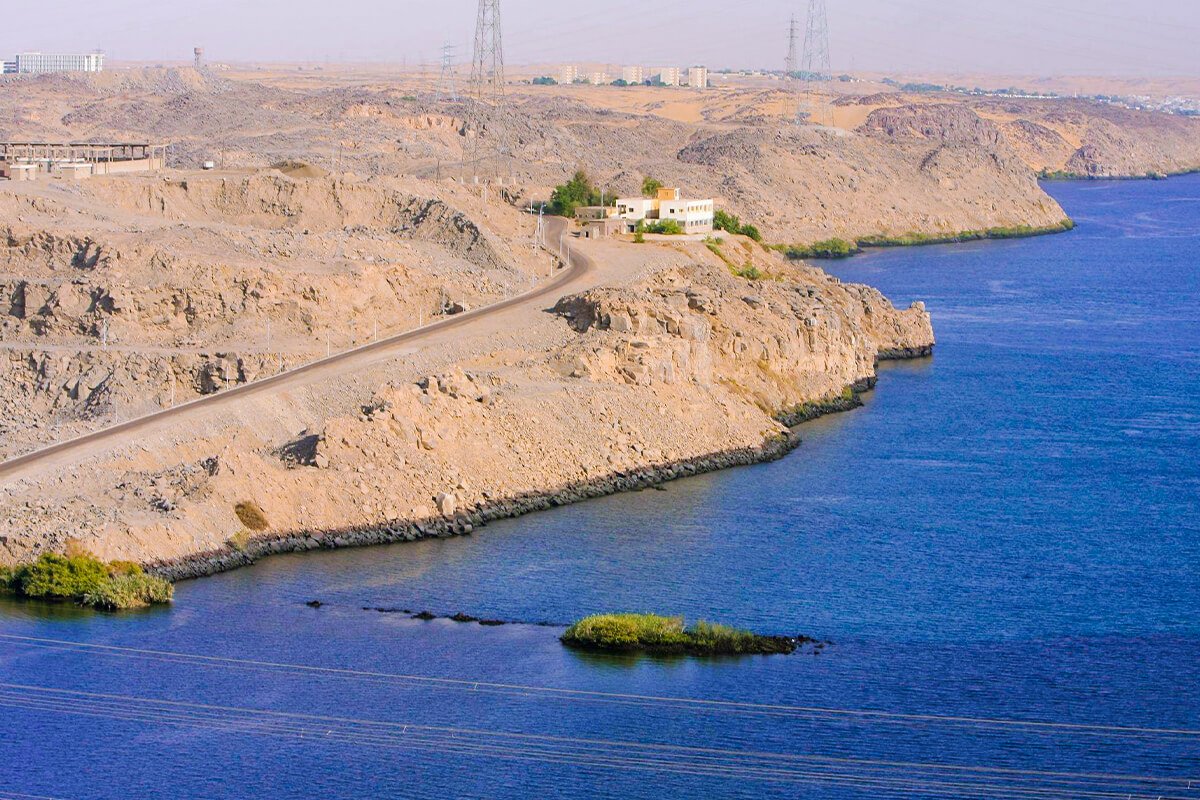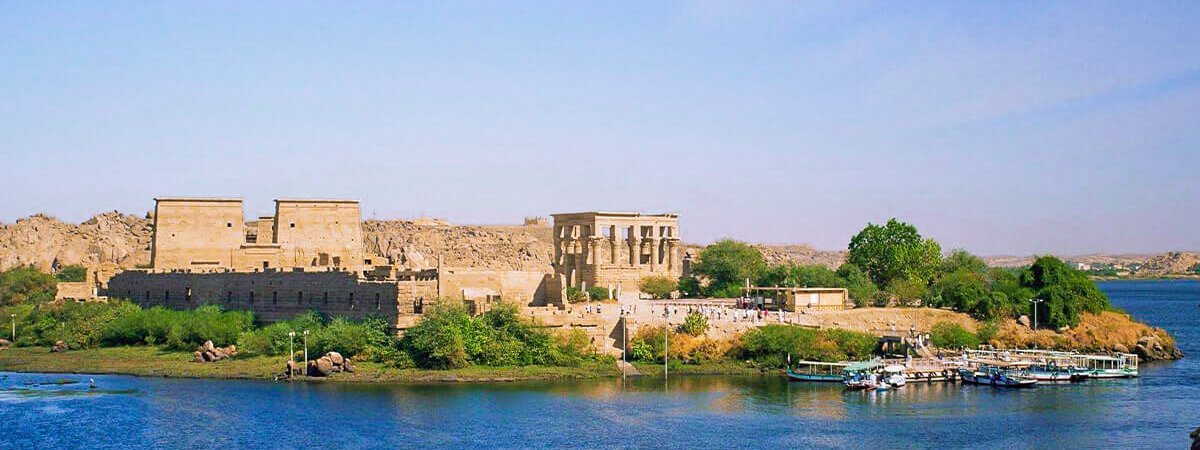Temple of Philae: Exploring the Mystical Beauty
The Temple of Philae, also known as the “Pearl of Egypt,” is a remarkable ancient structure nestled on the island of Philae in the Nile River. This temple complex is renowned for its captivating beauty, rich history, and intriguing legends. This article will delve into the mesmerizing world of the Temple of Philae, uncovering its secrets and exploring the mystical allure that has fascinated visitors for centuries.
Discover Egypt’s ancient wonders! Book your Egypt Vacation Packages now!
Historical Background

In understanding the Temple of Philae, we dive into a rich historical tapestry that encompasses its relocation, the original location, and its profound significance in ancient Egypt.
The Relocation of Philae
The narrative begins with the construction of the Aswan High Dam, a transformative feat of engineering in the 20th century that aimed to regulate the Nile River’s flow, provide electricity, and manage irrigation. However, this monumental undertaking came at a cost, as the rising waters of Lake Nasser threatened to submerge the sacred island of Philae and its temples.
Here, we explore the delicate balance between progress and preservation, where the UNESCO-led rescue operation emerged as a beacon of hope for safeguarding Philae’s treasures. This section illuminates the awe-inspiring efforts that saw colossal stone blocks meticulously relocated to the nearby Agilkia Island, recreating Philae’s sanctity on safer ground.
The Original Location of Philae
To comprehend Philae’s historical significance, we must first envision its original location – a serene island in the Nile, surrounded by glistening waters and lush greenery. Here, we paint a vivid picture of the ancient Philae, its strategic location, and its pivotal role in Egypt’s religious and cultural landscape.
The island’s lush landscape was not only home to the majestic Temple of Isis but also an essential center for pilgrimage, commerce, and learning. This segment transports you to the heart of ancient Egypt, where Philae stood as an enduring testament to human ingenuity and spiritual devotion.
Significance in Ancient Egypt
Delving deeper into the past, we explore the profound significance of Philae in the annals of ancient Egypt. The temple complex was not merely an architectural marvel but also a sanctuary devoted to the veneration of the goddess Isis, a central figure in Egyptian mythology.
Here, we delve into the myths and rituals that made Philae an epicenter of worship, drawing pilgrims from across the ancient world. Philae, nestled on the Nile’s fertile banks, was a symbol of life, fertility, and the eternal cycle of the river itself. In this section, we unravel the layers of history that make Philae not just a historic site but a living testament to the spiritual and cultural richness of ancient Egypt.
Don’t miss checking out our article:
- Explore Egypt Travel Tips to make the most of your trip.
- Uncover the Landmarks in Egypt and step into history.
Architectural Marvels
Intricately carved and meticulously planned, the Temple of Philae boasts an array of architectural wonders bound to leave any visitor in awe.
Design and Layout
The temple’s design and layout were a testament to ancient Egyptian architectural expertise. Carefully aligned with the stars and the Nile’s flow, the temple was a harmonious fusion of art, science, and spirituality. Visitors can expect to be amazed by the symmetrical precision that characterizes this ancient masterpiece, showcasing the Egyptians’ deep understanding of mathematics and engineering.
Temple Complex Overview
The Temple of Philae is not a solitary structure but a part of a larger temple complex encompassing a range of towers and structures. This segment provides a comprehensive overview of the complex, from the grand entrance through the propylaea to the inner sanctum of the temple, offering a glimpse into the spiritual journey that pilgrims of old would have undertaken.
The Temple of Isis
The heart of the complex, the Temple of Isis, stands as a symbol of devotion to the goddess Isis. Its grand pylons, intricate columns, and sanctuaries have been preserved to this day, and visitors will learn about its role in the worship of Isis and the rituals conducted within its sacred walls.
The Kiosk of Trajan
This unique structure, characterized by its open design and ornate columns, served as a chapel for the goddess Hathor. Visitors will gain insight into its purpose and the artistry that defines its architectural style.
The Gate of Hadrian
A structure that bridged the gap between ancient Egypt and the Roman Empire, the Gate of Hadrian is a significant part of the complex. This section highlights its historical importance and distinct architectural features that blend Egyptian and Roman styles.
Join us for adventure and discovery on our Egypt Day Tours.
Hieroglyphics and Inscriptions

As you explore the Temple of Philae, you’ll encounter a wealth of hieroglyphics and inscriptions that adorn its walls. This segment sheds light on the ancient Egyptian writing system, explaining the significance of these inscriptions in conveying myths, prayers, and historical accounts. Visitors can expect to decipher the stories etched in stone, a testament to the enduring power of the written word in ancient Egypt.
The Worship of Isis
Goddess Isis in Egyptian Mythology
The veneration of the goddess Isis holds a central place in the ancient Egyptian pantheon. In Egyptian mythology, Isis was revered as the mother goddess, symbolizing motherhood, fertility, and magic. She was also considered the protector of the dead, offering guidance and comfort in the afterlife. This section delves into the enchanting stories and attributes of Isis, showcasing her enduring significance in Egyptian culture and spirituality.
Role of the Temple in Isis Worship
The Temple of Philae was not merely a stone monument; it was a living testament to the devotion of the goddess Isis. The temple complex played a vital role in the worship of Isis, serving as a sacred site for pilgrims who came to pay homage to this revered deity. This part of the blog explores the role of the Temple of Philae as a center for Isis worship, highlighting the rituals, prayers, and offerings that were an integral part of the religious experience. Visitors will gain insight into the profound connection between the temple and the goddess, understanding the spiritual significance of this remarkable place.
Rituals and Ceremonies
To fully appreciate the temple’s historical and religious context, it’s essential to uncover the rituals and ceremonies within its hallowed halls. This section provides a glimpse into the rituals conducted by priests and devotees, such as offerings, processions, and purification ceremonies. By understanding the intricacies of these ancient practices, visitors can grasp the depth of devotion that characterized the worship of Isis at the Temple of Philae. The ceremonies that once resonated through these stone walls are a testament to the enduring power of faith and spirituality in ancient Egypt, and they continue to fascinate and inspire today.
Visiting the Temple

Location and Access
When planning a visit to the Temple of Philae, it’s crucial to understand its location and how to access this remarkable site. Situated on Agilkia Island in the Nile River, Philae is accessible from Aswan in southern Egypt. To reach the temple, visitors typically take a short boat ride from the mainland to the island. The journey is a scenic adventure, offering picturesque views of the river and the surrounding landscapes. This section provides insights into the practical aspects of getting to the temple, ensuring a smooth and memorable visit.
Ideal Time to Visit
Choosing the right time to explore the Temple of Philae can significantly enhance your experience. Egypt’s climate can be quite hot, so planning your visit during the cooler months, from October to April, is advisable. The early morning or late afternoon is also an excellent time to visit to avoid the heat and crowds. Exploring the temple during these times allows you to fully appreciate its beauty and historical significance without the discomfort of scorching temperatures. This part of the blog offers tips on timing your visit for maximum enjoyment.
Tickets and Entry Information
Before embarking on your journey to Philae, you must be informed about ticket prices, entry requirements, and any additional information that can make your visit more enjoyable. This section details ticket costs for both adults and children, as well as any discounts available. Additionally, you’ll find information about opening hours, ensuring you can plan your visit effectively. Understanding the logistics of entry is key to a hassle-free exploration of the temple.
Guided Tours and Local Guides
While exploring the Temple of Philae independently can be rewarding, many visitors opt for guided tours to enhance their experience. Knowledgeable guides can provide insights into the temple’s history, mythology, and architecture, adding depth to your visit. This section highlights the benefits of guided tours and how to arrange them, whether through organized tours or by hiring local guides. We’ll also offer tips on what to look for in a knowledgeable guide, ensuring you get the most out of your visit to this remarkable ancient site.
Exploring the Surroundings
The Philae Island Experience
Your journey to the Temple of Philae is more than just an isolated visit; it’s an opportunity to immerse yourself in the captivating surroundings of Philae Island. As you approach the temple, you’ll find yourself transported to a serene and picturesque landscape. The island’s lush greenery, with its palm trees and colorful flowers, provides a tranquil backdrop to the ancient stone structures. This section invites you to savor the Philae Island experience, encouraging you to take your time exploring the island’s natural beauty, perhaps with a leisurely stroll along its well-maintained paths.
The Beauty of the Nile
The Temple of Philae owes its enchanting location to the majestic Nile River, a lifeline that has sustained Egypt for millennia. As you explore the temple, take a moment to savor the breathtaking views of the Nile’s glistening waters. The serene and reflective atmosphere created by the river enhances the overall experience, adding an extra layer of mystique to your visit. Whether you choose to capture these moments in photographs or immerse yourself in the tranquil ambiance, the beauty of the Nile is an integral part of the Philae experience.
Nearby Attractions

Aswan High Dam
Venturing beyond the Temple of Philae, you’ll discover many nearby attractions that further enrich your journey. The Aswan High Dam is a modern engineering marvel and a testament to human ingenuity. This section offers insights into the dam’s history and significance in controlling the Nile’s flow, providing electricity, and supporting agriculture. You can explore the dam’s visitor center to gain a deeper understanding of its importance in contemporary Egypt.
Unfinished Obelisk
For those interested in ancient quarrying techniques and colossal monuments, visiting the Unfinished Obelisk is a must. This enormous, partially carved obelisk provides a window into the methods employed by the ancient Egyptians in shaping these colossal stone structures. Here, we uncover the story behind the Unfinished Obelisk and its place in Egypt’s archaeological heritage.
Nubian Village Visit
Delve into the rich cultural tapestry of the region by visiting a Nubian village, where you can interact with residents, explore their vibrant culture, and even enjoy traditional Nubian cuisine. This section provides insights into what you can expect during a Nubian village visit, highlighting the warm hospitality of the Nubian people and the opportunity to learn about their unique way of life, art, and traditions. These nearby attractions complement your visit to the Temple of Philae, creating a comprehensive and enriching experience in the heart of Aswan.
FAQ About The Temple of Philae
What is the best time to visit the Temple of Philae?
The best time to visit the [Temple of Philae] is during the winter months, from November to February, when the weather is mild and comfortable for exploring the temple complex.
How can I reach the Temple of Philae?
The [Temple of Philae] can be reached by boat ride from Aswan. Many tour operators in Aswan offer guided tours to the temple complex, providing transportation and informative commentary along the way.
Are there any entrance fees for visiting the Temple of Philae?
There is an entrance fee to visit the [Temple of Philae]. The price includes access to the entire temple complex, including the Temple of Isis, the Kiosk of Trajan, and the Temple of Hathor.
Can I take photographs inside the Temple of Philae?
Photography is allowed inside the [Temple of Philae]. However, checking with the temple authorities regarding any specific restrictions or guidelines is advisable.
Is any accommodation available near the Temple of Philae?
While there is no accommodation directly on Philae Island, several hotels and resorts in Aswan offer convenient access to the temple complex. Aswan provides a range of options to suit various budgets and preferences.
Are there other attractions near the Temple of Philae?
Apart from the [Temple of Philae], Aswan offers several other fascinating attractions, including the High Dam, the Unfinished Obelisk, and the Nubian Museum. Exploring these sites adds depth to the overall experience of visiting the region.
Conclusion
The Temple of Philae is a treasure trove of ancient Egyptian history and architecture. Its stunning beauty and the mystical legends surrounding it make it a must-visit destination for anyone interested in ancient civilizations. Stepping foot on the sacred ground of the temple complex is like embarking on a journey through time, where the grandeur of the past comes to life. Plan your visit to the [Temple of Philae] and get ready to be captivated by its enchanting allure.



